Dec . 09, 2024 21:26 Back to list
Polyethylene Pipe Fittings for Efficient Water Distribution and Reliable Connections
Understanding Polyethylene Pipe Fittings A Comprehensive Overview
Polyethylene (PE) pipe fittings have become integral to various industries, including water supply, irrigation, sewage management, and various industrial applications. Their popularity stems from their unique combination of durability, flexibility, and resistance to a range of environmental stresses. This article explores the characteristics, applications, and advantages of polyethylene pipe fittings, as well as installation and maintenance considerations.
What is Polyethylene?
Polyethylene is a thermoplastic polymer widely used in the manufacturing of pipe fittings. Its inherent properties, such as low density, corrosion resistance, and lightweight nature, make it a favorable choice for piping systems. The main types of polyethylene used in piping include High-Density Polyethylene (HDPE) and Medium-Density Polyethylene (MDPE). Both types are known for their strength and reliability, making them suitable for various applications, including potable water delivery and gas distribution.
Characteristics of Polyethylene Pipe Fittings
1. Durability PE pipe fittings can endure harsh environmental conditions, including extreme temperatures and UV exposure. Their resistance to cracking and impact makes them suitable for outdoor installations.
2. Flexibility Unlike rigid materials, polyethylene fittings can flex without breaking, allowing for easier installation in challenging terrains. This flexibility also helps reduce the chances of joint failure in applications prone to ground movement.
3. Corrosion Resistance Polyethylene does not corrode like metal fittings do, which is critical when transporting water or gas that could lead to contamination and safety hazards.
4. Lightweight The lightweight nature of PE fittings makes handling and installation more manageable than heavier materials, often leading to reduced labor costs and faster installation times.
5. Chemical Resistance Polyethylene is resistant to a variety of chemicals, making it suitable for industrial applications dealing with aggressive materials.
Applications of Polyethylene Pipe Fittings
Polyethylene pipe fittings are used in a wide array of applications
- Water Supply Systems PE fittings are commonly employed in municipal and rural water distribution systems due to their reliability and resistance to rust and corrosion.
- Irrigation Systems In agriculture, polyethylene fittings support drip and sprinkler irrigation systems, helping farmers manage water resources efficiently.
polyethylene pipe fittings

- Underground Gas Distribution MDPE fittings are often utilized in natural gas pipelines because of their strength and safety features
.- Wastewater Management PE fittings are used in sewage and drainage systems, benefiting from their durability and resistance to environmental stresses.
Advantages of Using Polyethylene Pipe Fittings
The advantages of choosing polyethylene fittings over traditional materials such as steel or PVC are numerous
- Cost-Effectiveness The long lifespan and minimal maintenance required for polyethylene fittings make them a more cost-effective option in the long run.
- Reduced Installation Time Due to their lightweight nature and ease of handling, installation times can be significantly reduced, leading to lower labor costs.
- Environmental Considerations Polyethylene is recyclable, which aligns with increasing environmental sustainability efforts in construction and infrastructure projects.
Installation and Maintenance
Proper installation is crucial to maximizing the benefits of polyethylene pipe fittings. Here are some tips
- Use Proper Tools Specialized tools are required for cutting and joining PE fittings. Heat fusion is a common method of joining, which creates a strong and leak-free connection.
- Follow Manufacturer Guidelines Always adhere to the specifications and guidelines provided by the manufacturer for installation and operational parameters.
- Regular Inspections Despite their durability, regular inspections are necessary to ensure there are no signs of wear or damage, especially in high-stress environments.
Conclusion
Polyethylene pipe fittings are an essential component of modern piping systems, offering a blend of durability, flexibility, and cost-effectiveness. Their applications in water supply, irrigation, and gas distribution illustrate their versatility across various sectors. As industries continue to focus on sustainable practices, the demand for polyethylene fittings is likely to grow, confirming their place as a reliable option for piping solutions in the future. Understanding the benefits and installation practices associated with polyethylene fittings can help ensure the longevity and efficiency of piping systems.
-
HDPE Natural Sheet: Durable, Food-Grade & Versatile Plastic Solutions
NewsAug.27,2025
-
Durable Glossy PVC Rigid Sheet | Premium High-Shine Panels
NewsAug.26,2025
-
Durable PP Rigid Sheet: Lightweight, Chemical Resistant Solutions
NewsAug.21,2025
-
PVC Grey Sheet for Extraction: Chemical Resistant & Durable
NewsAug.19,2025
-
Durable PVC Pipe Fittings for Plumbing & Irrigation Needs
NewsAug.18,2025
-
HDPE Steel Belt Reinforced Spiral Corrugated Pipe | High Strength
NewsAug.17,2025

